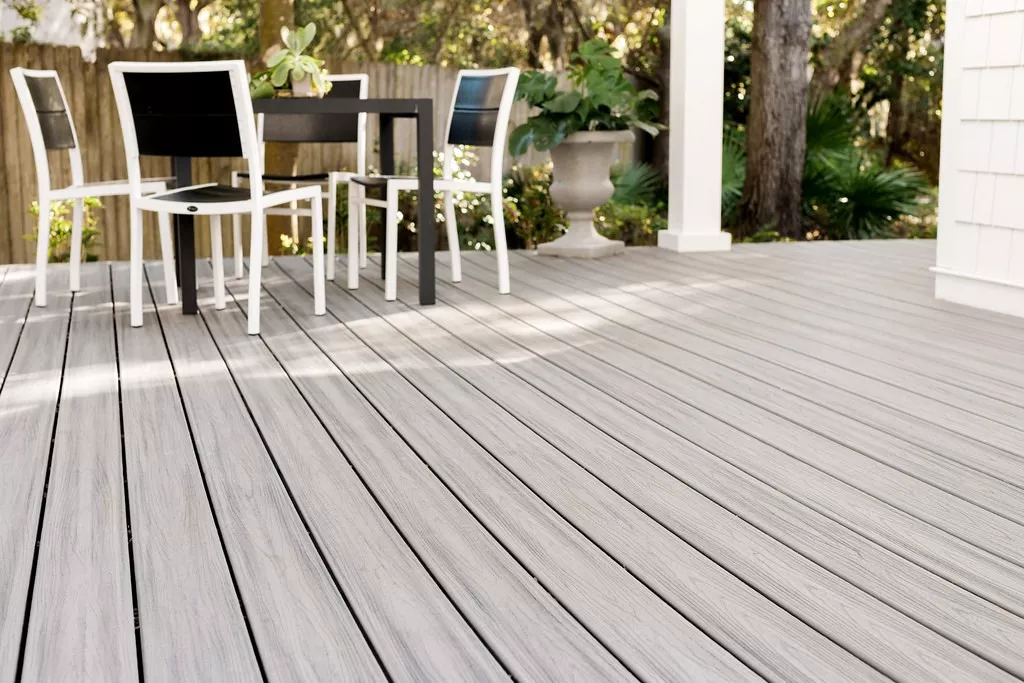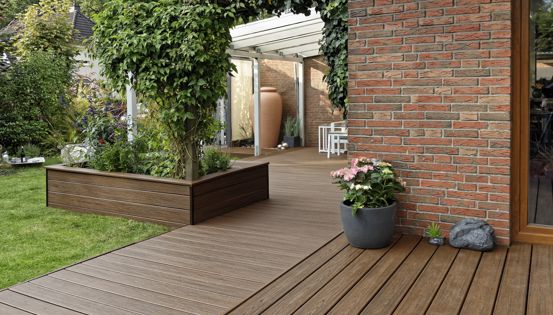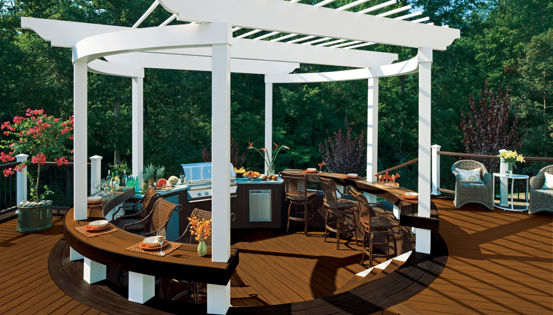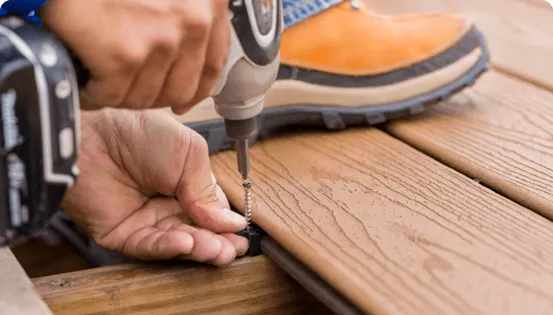While wood has traditionally been the most common type of decking material, alternatives to wood-like composite and PVC are becoming more popular each year. It’s easy to see their appeal, as they offer lower maintenance and longer lifespans and, when considering maintenance cost differences, can actually be more economical over time than wood. Ultimately, different materials are appropriate for different circumstances.
But what is PVC decking, and how does it compare to composite vs wood decking? Answering those questions is an important step toward determining which type of alternative decking material would work best for you.
The Difference Between PVC vs Vinyl Decking: Clearing Up Misconceptions
Before we dive into the pros and cons of PVC and composite decking materials, it’s important to point out that PVC decking is not vinyl decking. The two terms are often (and incorrectly) used interchangeably at a consumer level. However, there are some big differences between the two.
PVC deck boards are made from high-strength plastic and may include foaming agents to make them a strong-yet-lightweight material for use in deck boards. PVC deck boards and decking are suitable for use in building a deck -- just as you would use wood, composite, or aluminum. Some reputable manufacturers of PVC deck boards include TimberTech / AZEK and Endeck.
Vinyl decking cannot be made into deck boards. Rather, vinyl decking is a roll-out material that can be used as a protective membrane when waterproofing a deck. So, while you could use PVC decking to create the structure of your deck, vinyl “decking” could not be used in the same way. Some of the more well-known manufacturers of roll-out vinyl decking membranes include Tufdek and Duradek.
What is Vinyl Decking?
Vinyl decking is sometimes interchangeably referred to as PVC decking at a consumer level. While they’re both made from synthetic material, this is technically incorrect and the two are quite different. Vinyl decking is a thin, roll-out “membrane” that is spread across plywood decking planks and heat-sealed in place.
Vinyl decking is used to help eliminate water from seeping below the surface of a deck and is more of a protective membrane than a proper deck board material. You cannot use vinyl decking to create a solid structure that can bear weight on its own. It can only be used to create a waterproof seal when used over the top of another, sturdier material.
When you’re weighing the pros and cons of different materials to use in building a deck, in most cases, you may hear PVC decking referred to as “vinyl” because there is still a lot of confusion around the two terms. In this article, we’ll be talking exclusively about PVC decking and deck boards. (Although, if you plan to build a multi-level deck and want to waterproof the space beneath it, it’s beneficial to know where it’s appropriate to use roll-out vinyl decking, too, and to be aware of the distinction.)
What is PVC Decking?
PVC decking is made from polyvinyl chloride (PVC), which is a high-strength plastic. Like composites, PVC decking offers similar advantages as composites to consumers because it is also scratch-resistant, stain-resistant, and it doesn’t require the same high maintenance as wood. It’s also sold in a variety of colors, textures, and profiles.
PVC Decking Pros and Cons
When considering PVC decking, it’s important to weigh the positives and negatives of this material.
PVC Decking Pros: It’s resistant to invading pests, mold, and color fading. PVC looks high-end, and because it doesn’t require repainting or staining, there are minimal upkeep requirements. PVC decking is also manufactured using foaming agents, which makes it lighter and easier to move when installing. Many PVC manufacturers also offer very long warranty terms, which can be an important consideration. (Always read any decking product warranty and make sure key elements are mentioned, such as stain, fade, and structural degradation.
PVC Decking Cons: PVC decking is often priced at a premium over similar competitive composites at the same quality level. PVC has also been known to discolor when used with rubber or PVC products (like a welcome mat) and most manufacturers warn against their use.
Lastly, composite manufacturers often use a higher percentage of recycled material while PVC is often manufactured from virgin materials. If reducing your carbon footprint is important, research the manufacturer you’re considering for recycled content claims.
PVC vs Composite Decking
When comparing composite vs PVC decking, the main difference is appearance. Composites often better resemble natural wood. By contrast, PVC has a more obviously synthetic appearance. However, there are actually quite a few other differences between the two materials that are worth noting.
Cost
How much does a PVC deck cost? There is no simple answer because it depends on the quality of the materials. Some materials enjoy greater levels of protection from the elements than others, and PVC decking prices, in particular, can vary widely. But in general:
- Composite deck prices range between $4.50 and $13 per square foot.
- The average price of PVC decking ranges between $10 and $15 per square foot.
Lifespan
The lifespan of decking will depend on the quality of the material, and the basic manufacturing process employed. Generally, the average lifespan will usually fall in line with any associated warranties, but it’s important to note what the warranty covers. If you’re looking at products with an excellent extended warranty, you’ll find most composite decking is around 25-50 years. Both types of products offer warranties that could potentially last longer than treated lumber framing and, as such, is one of the most important considerations when choosing between wood decking and manufactured decking.
Maintenance
Both PVC and composite decking require less maintenance than wood. PVC and composites alike should be intermittently swept or hosed off to remove dirt and debris. That includes unclogging gaps in boards and cleaning up spills to prevent staining. Soft bristle brushing and soapy water may be necessary for stubborn dirt build-up or if mold is allowed to grow. Maintenance is very similar between the two product types.
Eco-Friendliness
Both composite and PVC decking can be made from recycled materials. As a pure synthetic material, PVC is fully recyclable. However, composites are generally constructed from a mixture of plastic and wood fibers, which are mixed together using heat and pressure in a co-extrusion process. As a result, some composites that use this method to create a finished product are not able to be recycled unless they can be easily returned to the manufacturer. However, most composites are made from recycled materials, lowering their impact on the environment.
Ease of Installation
Installation is similar for both products. PVC is a lighter-weight product, which makes it easier to handle on the job site. However, it can lead to a bit more “bounce” than composites once installed. Both are workable with standard woodworking tools. Both expand and contract with temperature changes and the manufacturer’s guidelines should be followed carefully. PVC and composites also both often have “hidden” fastening options that reduce the outward appearance of the installed decking for a more polished look.
Appearance
For many who are new to decking, it might be difficult to tell much of a difference between PVC and composite when looking at samples. In general terms, more composite manufacturers have a wood-like grain pattern and more PVC products have a more linear grain pattern. However, this is not a hard-and-fast rule and exceptions exist for both.
PVC often has a more aggressive texture than composites -- and that can be a plus or a minus, depending on your preference. Lastly, both product types offer multi-tonal or “streaked” products that are designed to resemble real wood. One PVC company even offers a laminated product that some feel is an extremely good aesthetic substitute for wood. Ultimately, beauty is in the eye of the beholder and aesthetics don’t necessarily represent a significant difference between these product types across manufacturers.
With a variety of options available to homeowners considering building a deck, wood does not have to be your first or only choice. Understanding the pros and cons of manufactured decking can help you decide which material is best for your needs.
If you're interested in learning more about composite decking, visit Trex to see how it differs from both PVC and Vinyl.







